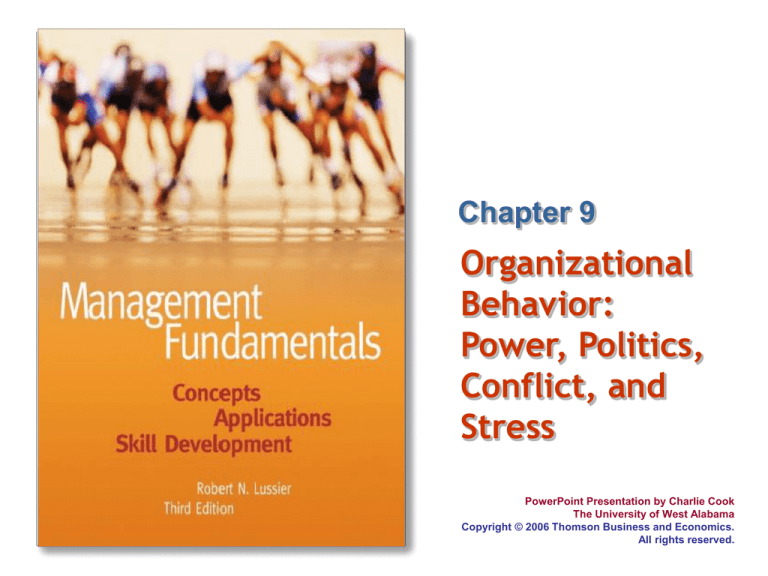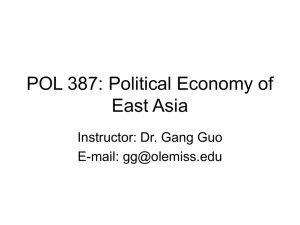
Chapter 9
Organizational
Behavior:
Power, Politics,
Conflict, and
Stress
PowerPoint Presentation by Charlie Cook
The University of West Alabama
Copyright © 2006 Thomson Business and Economics.
All rights reserved.
Learning Outcomes
After studying this chapter, you should be able to:
1. Describe each of the big five personality dimensions.
2. Explain the perception process, and identify the two factors that
influence it.
3. Describe the interrelationship among personality, perception,
and attitude, and explain the contribution of each to a manager’s
behavior.
4. Explain what job satisfaction is and why it is important.
5. Define power, and explain the difference between position and
personal power.
6. Identify the differences among reward, legitimate, and referent
power.
Copyright © 2006 Thomson Business and Economics. All rights reserved.
9–2
Learning Outcomes (cont’d)
7. Discuss how power and politics are related.
8. Describe how money and politics have a similar use.
9. Explain what networking, reciprocity, and coalitions have in
common.
10. List and define five conflict management styles.
11. List the steps in initiating and using the collaborative conflict
resolution model.
12. Explain the stress tug-of-war analogy.
Copyright © 2006 Thomson Business and Economics. All rights reserved.
9–3
Learning Outcomes (cont’d)
13. Define the following key terms:
organizational behavior
coalition
conflict
functional conflict
collaborative conflict resolution
model
BCF statement
mediator
arbitrator
stress
stressors
reciprocity
personality
perception
attribution
attitudes
Pygmalion effect
citizenship behavior
power
politics
networking
Copyright © 2006 Thomson Business and Economics. All rights reserved.
9–4
Ideas on Management at Black Entertainment Television
1. How would you describe Robert Johnson’s
personality?
2. How have perception and attitudes affected Robert
Johnson’s career? How did he deal with
discrimination?
3. What types of power does Johnson have? How does
he use his power?
4. How does Johnson effectively use organizational
politics at BET?
5. What types of negotiating and collaborating does
Johnson do?
Copyright © 2006 Thomson Business and Economics. All rights reserved.
9–5
Organizational Behavior
• Organizational Behavior (OB)
– The study of actions that affect performance in
the workplace.
– The goal of OB theorists is to explain and
predict actions and how they will affect
performance.
– OB focuses on three levels: individual, group,
and organizational.
Copyright © 2006 Thomson Business and Economics. All rights reserved.
9–6
Personality
• Personality
– A combination of behavioral, mental, and
emotional traits that define an individual.
– Based on genetics and environmental factors.
– Affects the long-term
performance of individuals.
Copyright © 2006 Thomson Business and Economics. All rights reserved.
9–7
Single Traits of Personality
• Locus of control
– External: outside forces are in control.
– Internal: individual is in control.
• Optimism versus Pessimism
• Risk Propensity
– From risk taking to risk avoidance.
• Machiavellianism
– Based on the belief that the ends can justify the
means and power should be used to reach
desired ends.
Copyright © 2006 Thomson Business and Economics. All rights reserved.
9–8
The Big Five Personality Dimensions
From
Trait
To
Extrovert
Extraversion
Introvert
Cooperative
Agreeableness
Competitive
Emotionally stable
Emotionalism
Emotionally unstable
Responsible/
Dependable
Conscientiousness
Irresponsible/
Undependable
Open
Openness to
Experience
Closed
Trait Continuum
Copyright © 2006 Thomson Business and Economics. All rights reserved.
9–9
Perception
• Perception
– The process of selecting, organizing, and
interpreting environmental information.
– Based on internal factors (e.g., personality) and
external factors (e.g., accuracy of information).
– Self-esteem (self-concept) describes how
individuals perceive themselves.
Copyright © 2006 Thomson Business and Economics. All rights reserved.
9–10
The Attribution Process
• Attribution
– The process of determining
the reason for an individual’s
behavior and whether that
behavior is situational or
intentional.
– Situational
• Out of the control
of the individual.
– Intentional
• The individual is
consciously behaving.
Exhibit 9–1
Copyright © 2006 Thomson Business and Economics. All rights reserved.
9–11
Bias in Perception
•
Selectivity
–
•
Frame of Reference
–
•
Seeing things from your point of view rather than
another’s.
Stereotypes
–
•
Screening information in favor of the desired outcome.
The process of generalizing the behavior of a group and
then applying the generalities to one individual.
Expectations
–
Perceiving what is expected to be perceived.
Copyright © 2006 Thomson Business and Economics. All rights reserved.
9–12
Attitudes
• Attitudes
– Positive or negative evaluations of people,
things, and situations.
• Attitude Formation
– Attitudes are based on perceptions.
• Attitudes and Behavior
– Attitudes reflect feelings and affect behavior.
• Pygmalion Effect
– Managers’ attitudes toward and expectations of
employees and how they treat them largely
determine employee performance.
Copyright © 2006 Thomson Business and Economics. All rights reserved.
9–13
Attitudes (cont’d)
• Attitudes and Job Satisfaction
– Job satisfaction is a person’s attitude toward
his or her job.
• Job Satisfaction and Performance
– Affects absenteeism and turnover.
– Affects off-the-job behaviors.
• Determinants of Job Satisfaction
– Personality, the work itself, compensation,
growth and upward mobility, coworkers,
management
Copyright © 2006 Thomson Business and Economics. All rights reserved.
9–14
Power
• Power
– The ability to influence others’ behavior.
• Position power
– Derived from top management and is delegated
down the chain of command.
• Personal power
– Derived from followers, based
on an individual’s behavior.
• Empowerment
– Giving power to employees
Copyright © 2006 Thomson Business and Economics. All rights reserved.
9–15
Sources and Bases of Power
• How to Increase Your Power
– You can increase your power without taking
power away from others.
– Generally, power is given to those who get
results and have good human relations skills.
Exhibit 9–2
Copyright © 2006 Thomson Business and Economics. All rights reserved.
9–16
Types of Power
• Coercive Power
– Involves threats and/or punishment to influence
compliance.
• Connection Power
– Based on the user’s relationship with influential
people.
• Reward Power
– Based on the user’s ability to influence others
with something of value to them.
Copyright © 2006 Thomson Business and Economics. All rights reserved.
9–17
Types of Power (cont’d)
• Legitimate Power
– Based on the user’s position power in the
organization.
• Referent Power
– Based on the user’s personal power
relationship with others.
• Information Power
– Based on data desired by others.
• Expert Power
– Based on the user’s skills and knowledge.
Copyright © 2006 Thomson Business and Economics. All rights reserved.
9–18
Copyright © 2006 Thomson Business and Economics. All rights reserved.
9–19
Organizational Politics
• Politics
– The process of gaining and using power.
• Political Behaviors
– Networking
•
The process of developing relationships for the
purpose of socializing and politicking.
– Reciprocity
•
Involves creating obligations and developing
alliances and using them to accomplish objectives.
– Coalition
•
A network of alliances that will help a manager
achieve an objective.
Copyright © 2006 Thomson Business and Economics. All rights reserved.
9–20
Political Behaviors and Guidelines for Developing Political Skills
Exhibit 9–3
Copyright © 2006 Thomson Business and Economics. All rights reserved.
9–21
Copyright © 2006 Thomson Business and Economics. All rights reserved.
9–22
Managing Conflict
• Conflict
– Exists whenever people are in disagreement
and opposition.
• The Psychological Contract
– Is composed of the implicit expectations of
each party.
– Conflict arises when the contract is broken,
which happens when:
•
•
We fail to make explicit our own expectations and
fail to inquire into the expectations of others.
We assume that others have the same expectations
that we hold.
Copyright © 2006 Thomson Business and Economics. All rights reserved.
9–23
Managing Conflict (cont’d)
• Functional Conflict
– Exists when disagreement and opposition
support the achievement of organizational
goals.
• Dysfunctional Conflict
– Exists when conflict prevents the achievement
of organizational goals.
– Complacency and confrontation are both
dysfunctional forms of conflict.
Copyright © 2006 Thomson Business and Economics. All rights reserved.
9–24
Conflict Management Styles
Exhibit 9–4
Copyright © 2006 Thomson Business and Economics. All rights reserved.
9–25
Copyright © 2006 Thomson Business and Economics. All rights reserved.
9–26
Negotiation, Collaboration, and Mediation
• Negotiating
– A process in which two or more parties in
conflict attempt to come to an agreement.
– Can be hampered by zero-sum attitudes of
parties.
• Collaboration
– The parties work together to solve a problem.
• Mediation
– The use of a neutral third party to help the
parties resolve a conflict.
Copyright © 2006 Thomson Business and Economics. All rights reserved.
9–27
The Negotiation Process
Exhibit 9–5
Copyright © 2006 Thomson Business and Economics. All rights reserved.
9–28
The Collaborative Conflict Resolution Model
Exhibit 9–6
Copyright © 2006 Thomson Business and Economics. All rights reserved.
9–29
The Collaborative Conflict Resolution Model (cont’d)
Exhibit 9–6 cont’d
Copyright © 2006 Thomson Business and Economics. All rights reserved.
9–30
The Collaborative Conflict Resolution Model (cont’d)
Exhibit 9–6 cont’d
Copyright © 2006 Thomson Business and Economics. All rights reserved.
9–31
Stress
•
Stress
–
•
Stressors
–
•
Factors that cause people to feel overwhelmed by anxiety,
tension, and/or pressure.
Functional Stress
–
•
The body’s reaction to environmental demands.
Helps improve performance by challenging and
motivating people to meet objectives.
Dysfunctional stress
–
Stress that is severe enough to lead to burnout.
• Burnout is a constant lack of interest
and motivation to perform one’s job
due to stress.
Copyright © 2006 Thomson Business and Economics. All rights reserved.
9–32
Relaxation
Exercises
Exhibit 9–7
Copyright © 2006 Thomson Business and Economics. All rights reserved.
9–33
Copyright © 2006 Thomson Business and Economics. All rights reserved.
9–34
The Stress Tug-of-War
Exhibit 9–8
Copyright © 2006 Thomson Business and Economics. All rights reserved.
9–35






